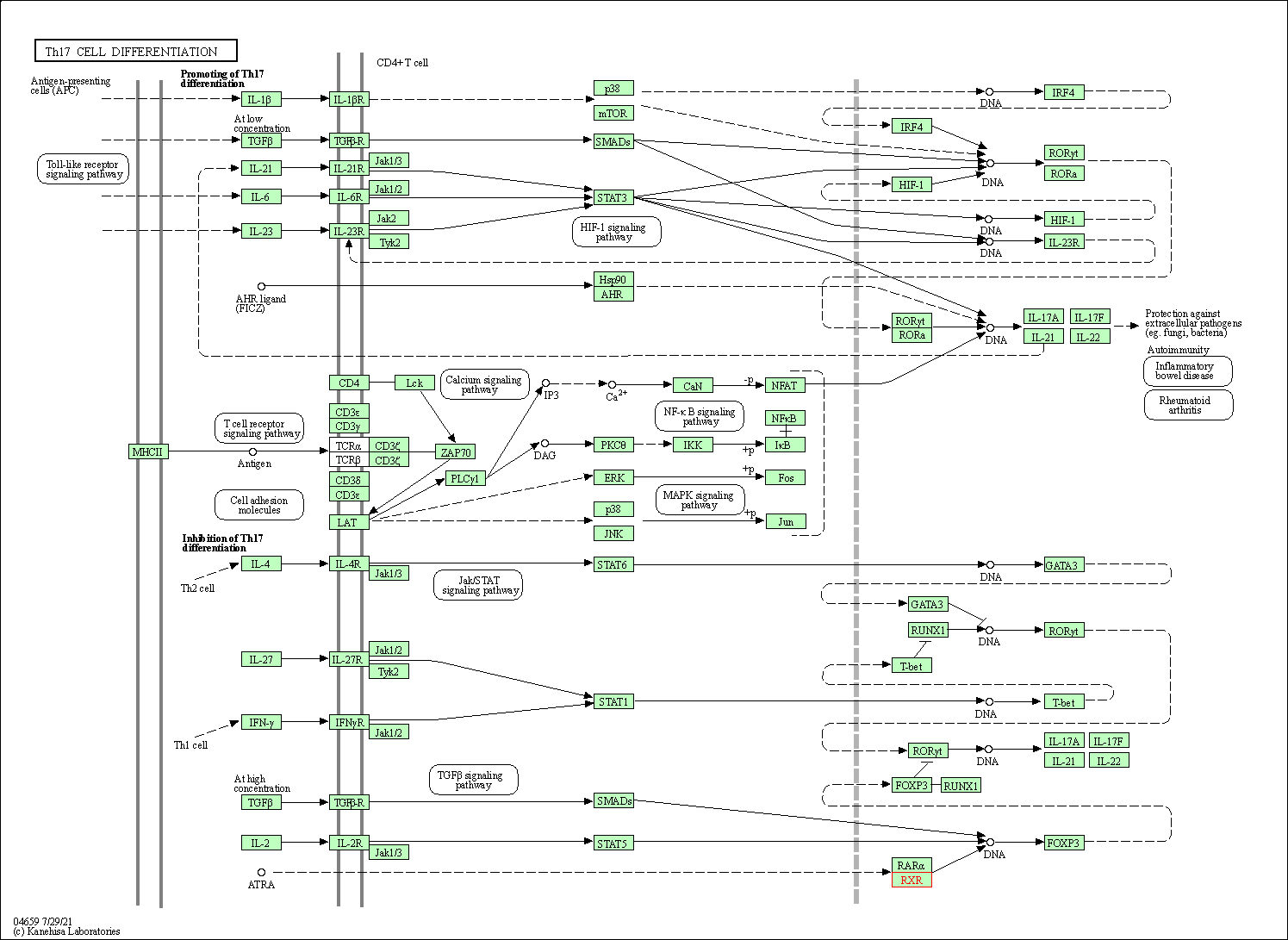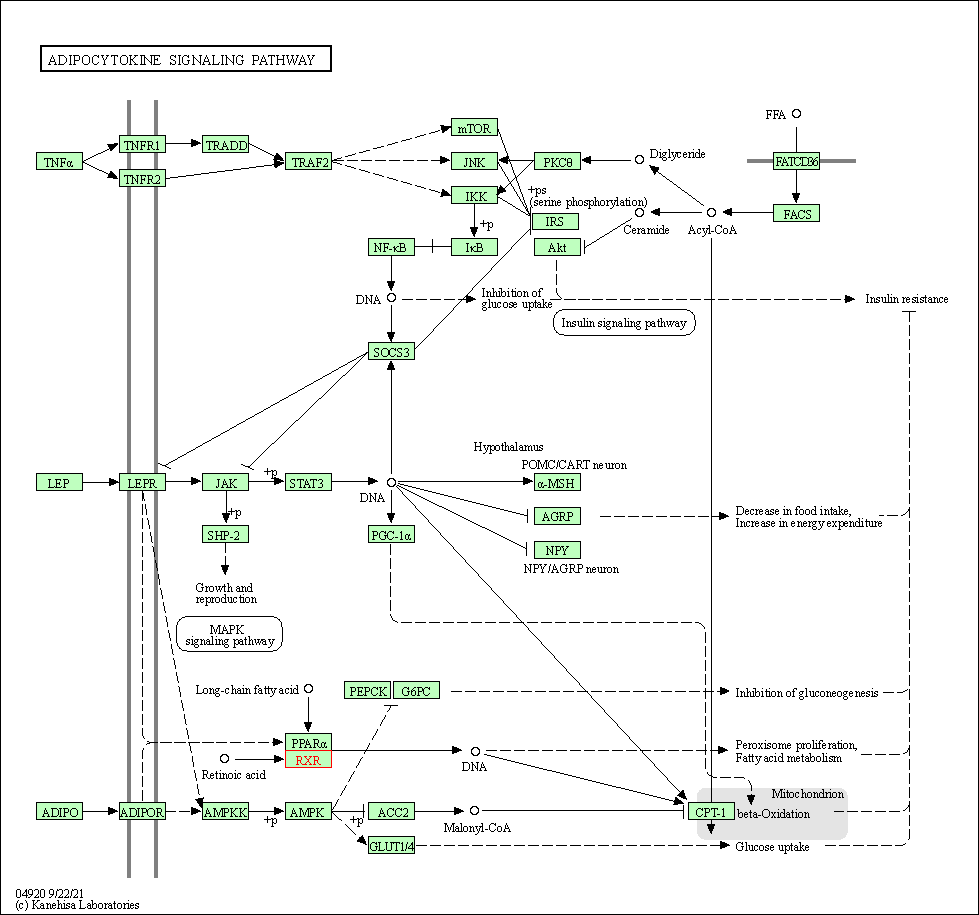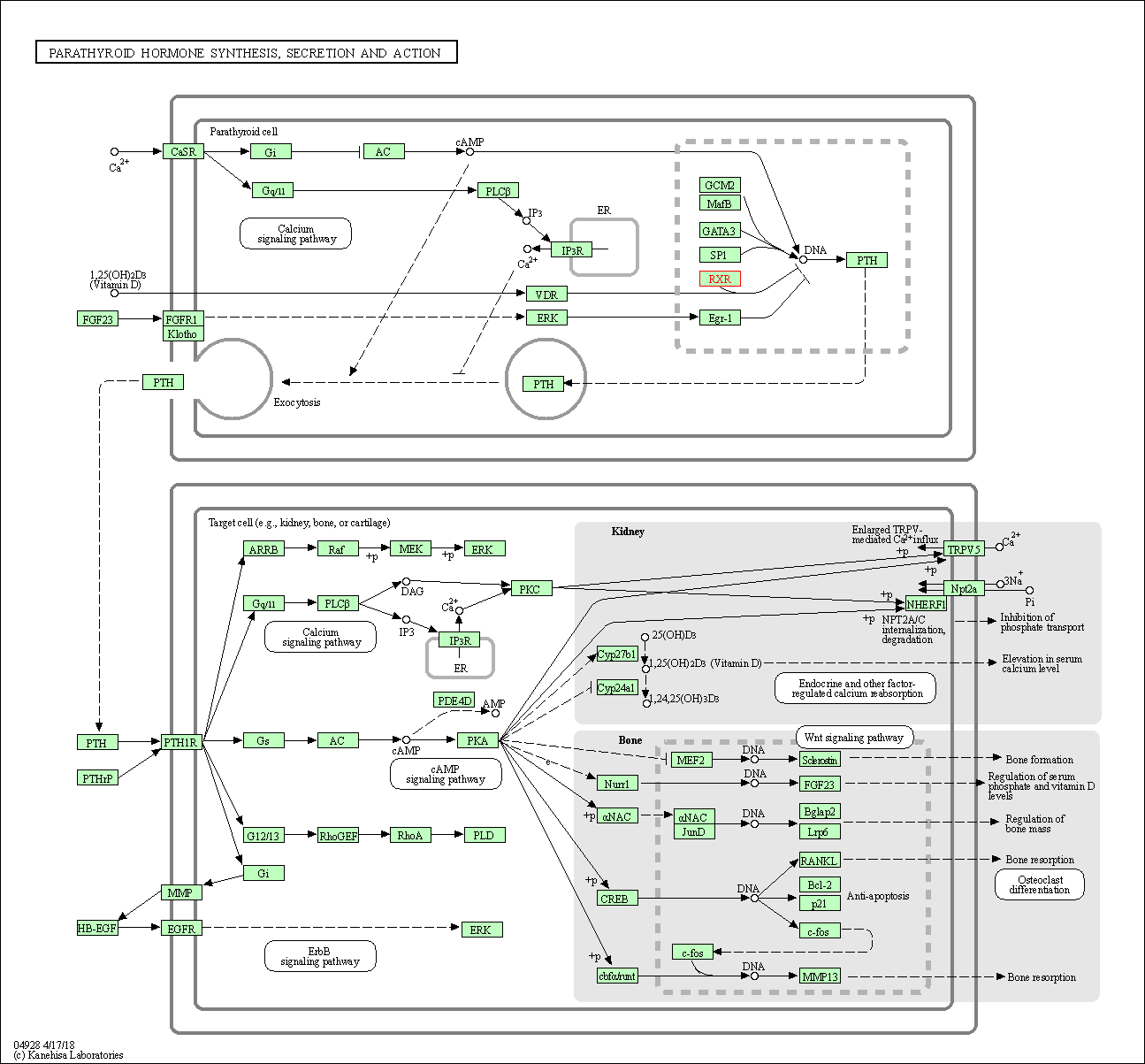Target Information
| Target General Information | Top | |||||
|---|---|---|---|---|---|---|
| Target ID |
T60077
(Former ID: TTDI03515)
|
|||||
| Target Name |
Retinoic acid receptor RXR-beta (RXRB)
|
|||||
| Synonyms |
Retinoid X receptor beta; Nuclear receptor subfamily 2 group B member 2; NR2B2
Click to Show/Hide
|
|||||
| Gene Name |
RXRB
|
|||||
| Target Type |
Successful target
|
[1] | ||||
| Disease | [+] 1 Target-related Diseases | + | ||||
| 1 | Kaposi sarcoma [ICD-11: 2B57] | |||||
| Function |
Retinoic acid receptors bind as heterodimers to their target response elements in response to their ligands, all-trans or 9-cis retinoic acid, and regulate gene expression in various biological processes. The RAR/RXR heterodimers bind to the retinoic acid response elements (RARE). Receptor for retinoic acid.
Click to Show/Hide
|
|||||
| BioChemical Class |
Nuclear hormone receptor
|
|||||
| UniProt ID | ||||||
| Sequence |
MSWAARPPFLPQRHAAGQCGPVGVRKEMHCGVASRWRRRRPWLDPAAAAAAAVAGGEQQT
PEPEPGEAGRDGMGDSGRDSRSPDSSSPNPLPQGVPPPSPPGPPLPPSTAPSLGGSGAPP PPPMPPPPLGSPFPVISSSMGSPGLPPPAPPGFSGPVSSPQINSTVSLPGGGSGPPEDVK PPVLGVRGLHCPPPPGGPGAGKRLCAICGDRSSGKHYGVYSCEGCKGFFKRTIRKDLTYS CRDNKDCTVDKRQRNRCQYCRYQKCLATGMKREAVQEERQRGKDKDGDGEGAGGAPEEMP VDRILEAELAVEQKSDQGVEGPGGTGGSGSSPNDPVTNICQAADKQLFTLVEWAKRIPHF SSLPLDDQVILLRAGWNELLIASFSHRSIDVRDGILLATGLHVHRNSAHSAGVGAIFDRV LTELVSKMRDMRMDKTELGCLRAIILFNPDAKGLSNPSEVEVLREKVYASLETYCKQKYP EQQGRFAKLLLRLPALRSIGLKCLEHLFFFKLIGDTPIDTFLMEMLEAPHQLA Click to Show/Hide
|
|||||
| 3D Structure | Click to Show 3D Structure of This Target | AlphaFold | ||||
| HIT2.0 ID | T01P7T | |||||
| Drugs and Modes of Action | Top | |||||
|---|---|---|---|---|---|---|
| Approved Drug(s) | [+] 1 Approved Drugs | + | ||||
| 1 | Alitretinoin | Drug Info | Approved | Kaposi sarcoma | [2], [3] | |
| Mode of Action | [+] 3 Modes of Action | + | ||||
| Agonist | [+] 1 Agonist drugs | + | ||||
| 1 | Alitretinoin | Drug Info | [1] | |||
| Inhibitor | [+] 1 Inhibitor drugs | + | ||||
| 1 | AGN-34 | Drug Info | [4] | |||
| Antagonist | [+] 1 Antagonist drugs | + | ||||
| 1 | LG100754 | Drug Info | [5] | |||
| Cell-based Target Expression Variations | Top | |||||
|---|---|---|---|---|---|---|
| Cell-based Target Expression Variations | ||||||
| Drug Binding Sites of Target | Top | |||||
|---|---|---|---|---|---|---|
| Ligand Name: Methoprene acid | Ligand Info | |||||
| Structure Description | Crystal structure of the LXRalfa-RXRbeta LBD heterodimer | PDB:1UHL | ||||
| Method | X-ray diffraction | Resolution | 2.90 Å | Mutation | No | [6] |
| PDB Sequence |
EMPVDRILEA
307 ELAVEQSPND334 PVTNICQAAD344 KQLFTLVEWA354 KRIPHFSSLP364 LDDQVILLRA 374 GWNELLIASF384 SHRSIDVRDG394 ILLATGLHVH404 RNSAHSAGVG414 AIFDRVLTEL 424 VSKMRDMRMD434 KTELGCLRAI444 ILFNPDAKGL454 SNPSEVEVLR464 EKVYASLETY 474 CKQKYPEQQG484 RFAKLLLRLP494 ALRSIGLKCL504 EHLFFFKLIG514 DTPIDTFLME 524 MLEA
|
|||||
|
|
||||||
| Ligand Name: LG100268 | Ligand Info | |||||
| Structure Description | The structure of the human retinoid-X-receptor beta ligand binding domain in complex with the specific synthetic agonist LG100268 | PDB:1H9U | ||||
| Method | X-ray diffraction | Resolution | 2.70 Å | Mutation | No | [7] |
| PDB Sequence |
MPVDRILEAE
308 LAVPVTNICQ341 AADKQLFTLV351 EWAKRIPHFS361 SLPLDDQVIL371 LRAGWNELLI 381 ASFSHRSIDV391 RDGILLATGL401 HVHRNSAHSA411 GVGAIFDRVL421 TELVSKMRDM 431 RMDKTELGCL441 RAIILFNPDA451 KGLSNPSEVE461 VLREKVYASL471 ETYCKQKYPE 481 QQGRFAKLLL491 RLPALRSIGL501 KCLEHLFFFK511 LIGDTPIDTF521 L |
|||||
|
|
VAL336
4.193
ILE339
3.503
CYS340
4.234
ALA342
2.849
ALA343
3.514
GLN346
3.604
TRP376
3.669
ASN377
3.914
LEU380
3.230
ILE381
3.404
PHE384
3.384
ARG387
2.940
LEU396
4.788
|
|||||
| Click to View More Binding Site Information of This Target with Different Ligands | ||||||
| Different Human System Profiles of Target | Top |
|---|---|
|
Human Similarity Proteins
of target is determined by comparing the sequence similarity of all human proteins with the target based on BLAST. The similarity proteins for a target are defined as the proteins with E-value < 0.005 and outside the protein families of the target.
A target that has fewer human similarity proteins outside its family is commonly regarded to possess a greater capacity to avoid undesired interactions and thus increase the possibility of finding successful drugs
(Brief Bioinform, 21: 649-662, 2020).
Human Tissue Distribution
of target is determined from a proteomics study that quantified more than 12,000 genes across 32 normal human tissues. Tissue Specificity (TS) score was used to define the enrichment of target across tissues.
The distribution of targets among different tissues or organs need to be taken into consideration when assessing the target druggability, as it is generally accepted that the wider the target distribution, the greater the concern over potential adverse effects
(Nat Rev Drug Discov, 20: 64-81, 2021).
Human Pathway Affiliation
of target is determined by the life-essential pathways provided on KEGG database. The target-affiliated pathways were defined based on the following two criteria (a) the pathways of the studied target should be life-essential for both healthy individuals and patients, and (b) the studied target should occupy an upstream position in the pathways and therefore had the ability to regulate biological function.
Targets involved in a fewer pathways have greater likelihood to be successfully developed, while those associated with more human pathways increase the chance of undesirable interferences with other human processes
(Pharmacol Rev, 58: 259-279, 2006).
Biological Network Descriptors
of target is determined based on a human protein-protein interactions (PPI) network consisting of 9,309 proteins and 52,713 PPIs, which were with a high confidence score of ≥ 0.95 collected from STRING database.
The network properties of targets based on protein-protein interactions (PPIs) have been widely adopted for the assessment of target’s druggability. Proteins with high node degree tend to have a high impact on network function through multiple interactions, while proteins with high betweenness centrality are regarded to be central for communication in interaction networks and regulate the flow of signaling information
(Front Pharmacol, 9, 1245, 2018;
Curr Opin Struct Biol. 44:134-142, 2017).
Human Similarity Proteins
Human Tissue Distribution
Human Pathway Affiliation
Biological Network Descriptors
|
|
| Protein Name | Pfam ID | Percentage of Identity (%) | E value |
|---|---|---|---|
| Intersectin-2 (ITSN2) | 32.479 (38/117) | 4.00E-03 |
|
Note:
If a protein has TS (tissue specficity) scores at least in one tissue >= 2.5, this protein is called tissue-enriched (including tissue-enriched-but-not-specific and tissue-specific). In the plots, the vertical lines are at thresholds 2.5 and 4.
|





| KEGG Pathway | Pathway ID | Affiliated Target | Pathway Map |
|---|---|---|---|
| PPAR signaling pathway | hsa03320 | Affiliated Target |

|
| Class: Organismal Systems => Endocrine system | Pathway Hierarchy | ||
| Th17 cell differentiation | hsa04659 | Affiliated Target |

|
| Class: Organismal Systems => Immune system | Pathway Hierarchy | ||
| Thyroid hormone signaling pathway | hsa04919 | Affiliated Target |

|
| Class: Organismal Systems => Endocrine system | Pathway Hierarchy | ||
| Adipocytokine signaling pathway | hsa04920 | Affiliated Target |

|
| Class: Organismal Systems => Endocrine system | Pathway Hierarchy | ||
| Parathyroid hormone synthesis, secretion and action | hsa04928 | Affiliated Target |

|
| Class: Organismal Systems => Endocrine system | Pathway Hierarchy | ||
| Degree | 9 | Degree centrality | 9.67E-04 | Betweenness centrality | 2.17E-05 |
|---|---|---|---|---|---|
| Closeness centrality | 2.09E-01 | Radiality | 1.37E+01 | Clustering coefficient | 8.33E-02 |
| Neighborhood connectivity | 1.53E+01 | Topological coefficient | 1.85E-01 | Eccentricity | 11 |
| Download | Click to Download the Full PPI Network of This Target | ||||
| Chemical Structure based Activity Landscape of Target | Top |
|---|---|
| Drug Property Profile of Target | Top | |
|---|---|---|
| (1) Molecular Weight (mw) based Drug Clustering | (2) Octanol/Water Partition Coefficient (xlogp) based Drug Clustering | |
|
|
||
| (3) Hydrogen Bond Donor Count (hbonddonor) based Drug Clustering | (4) Hydrogen Bond Acceptor Count (hbondacc) based Drug Clustering | |
|
|
||
| (5) Rotatable Bond Count (rotbonds) based Drug Clustering | (6) Topological Polar Surface Area (polararea) based Drug Clustering | |
|
|
||
| "RO5" indicates the cutoff set by lipinski's rule of five; "D123AB" colored in GREEN denotes the no violation of any cutoff in lipinski's rule of five; "D123AB" colored in PURPLE refers to the violation of only one cutoff in lipinski's rule of five; "D123AB" colored in BLACK represents the violation of more than one cutoffs in lipinski's rule of five | ||
| Co-Targets | Top | |||||
|---|---|---|---|---|---|---|
| Co-Targets | ||||||
| Target Poor or Non Binders | Top | |||||
|---|---|---|---|---|---|---|
| Target Poor or Non Binders | ||||||
| Target Regulators | Top | |||||
|---|---|---|---|---|---|---|
| Target-interacting Proteins | ||||||
| Target-Related Models and Studies | Top | |||||
|---|---|---|---|---|---|---|
| Target Validation | ||||||
| References | Top | |||||
|---|---|---|---|---|---|---|
| REF 1 | Retinoic acid receptors and retinoid X receptors: interactions with endogenous retinoic acids. Proc Natl Acad Sci U S A. 1993 Jan 1;90(1):30-4. | |||||
| REF 2 | URL: http://www.guidetopharmacology.org Nucleic Acids Res. 2015 Oct 12. pii: gkv1037. The IUPHAR/BPS Guide to PHARMACOLOGY in 2016: towards curated quantitative interactions between 1300 protein targets and 6000 ligands. (Ligand id: 2645). | |||||
| REF 3 | Natural products as sources of new drugs over the last 25 years. J Nat Prod. 2007 Mar;70(3):461-77. | |||||
| REF 4 | Farnesoid X receptor: from structure to potential clinical applications. J Med Chem. 2005 Aug 25;48(17):5383-403. | |||||
| REF 5 | Activation of specific RXR heterodimers by an antagonist of RXR homodimers. Nature. 1996 Oct 3;383(6599):450-3. | |||||
| REF 6 | Crystal structure of the heterodimeric complex of LXRalpha and RXRbeta ligand-binding domains in a fully agonistic conformation. EMBO J. 2003 Sep 15;22(18):4625-33. | |||||
| REF 7 | The structural basis for the specificity of retinoid-X receptor-selective agonists: new insights into the role of helix H12. J Biol Chem. 2002 Mar 29;277(13):11385-91. | |||||
If You Find Any Error in Data or Bug in Web Service, Please Kindly Report It to Dr. Zhou and Dr. Zhang.

